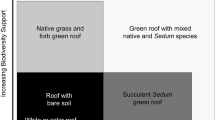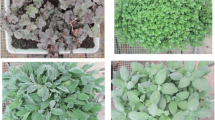Abstract
Plant-based stormwater management systems such as green roofs are typically composed exclusively of vascular plants. Yet, mosses have several desirable properties that could warrant their more widespread use in green roof applications. In natural systems mosses are important primary colonizers of bare ground, and their establishment improves water storage and provides numerous soil benefits including carbon and nitrogen sequestration. Additionally, mosses often facilitate the establishment and survival of vascular plants at otherwise environmentally harsh or stressful sites. Despite their potential value, few studies have investigated the functional performance of mosses on green roofs. In this study we evaluated the establishment success and potential stormwater performance of three candidate moss species. We also directly compared the runoff and thermal characteristics of replicate moss covered green roofs to vascular planted and bare roofs. Candidate mosses had high water holding capacities, storing 8–10 times their weight in water compared to only 1.3 times for typical green roof medium. Mock-up roof sections composed of mosses and medium had delayed and reduced runoff flows relative to medium only sections, although the magnitude of these effects varied with moss species. In field trials all three mosses survived a harsh rooftop environment with limited summer irrigation, although lateral growth after one year was minimal. Green roofs planted solely with Racomitrium canescens had between 12–24% higher stormwater retention than vascular or medium only roofs. Moss cover also ameliorated temperature fluctuations on green roofs. Hourly heating rates were buffered to a similar degree (less than half that of surface temperatures) 5 cm below the surface of both moss covered and medium only roofs. In contrast, cooling under the surface of the moss roof was nearly 6 times faster than under the medium only roof. These results demonstrate the potential for mosses to be valuable components of green roofs, either in combination with vascular plants or planted exclusively.


Similar content being viewed by others
References
Adams KJ, Preston CD (1992) Evidence for the effects of atmospheric pollution on bryophytes from national and local recording. In: Harding PT (ed) Biological recording of changes in British wildlife. HMSO, London, pp 31–43
Bednarek O (2003) Niphotrichum canescens. Flora of North America 27:287
Bengtsson L (2005a) Hydrological function of a thin extensive green roof in southern Sweden. Nord Hydrol 36:259–268
Bengtsson L (2005b) Peak flows from a sedum-moss roof. Nord Hydrol 36:269–280
Chiaffredo M, Denayer FO (2004) Mosses, A necessary step for perennial plant dynamics. Proceedings Greening Rooftops for Sustainable Communities Conference, Portland Oregon, June 2–4 2004
Ducket JG, Burch J, Fletcher PW, Matcham HW, Read DJ, Russel AJ, Pressel S (2004) In vitro cultivation of bryophytes: a review of practicalities, problems, progress and promise. J Bryol 26:3–20
Dunnet N, Kingsbury N (2008) Planting green roofs and living walls. Timber, Portland
Dunnet N, Nagase A, Booth R, Grime P (2008) Influence of vegetation composition on runoff in two simulated green roof experiments. Urban Ecosyst 11:385–398
Evans D, and Associates (2008) Cost benefit evaluation of ecoroofs. City of Portland Bureau of Environmental Services: 1–22
Fahey T, Knapp A (2007) Principles and standards for measuring primary production. Oxford University Press US
Gilbert OL (1971) Urban bryophyte communities in north-east England. Trans Br Bryol Soc 6:306–316
Gedge D, Kadas G (2004) Bugs, bees, and spiders: Green roof design for rare invertebrates. Greening Rooftops for Sustainable Communities. Proceedings Greening Rooftops for Sustainable Communities Conference, Portland, Oregon, June 2–4 2004
Getter K, Rowe D (2006) The role of extensive green roofs in sustainable development. HortScience 41:1276–1285
Hutchinson D, Abrams P, Retzlaff R, Liptan T (2003) Stormwater monitoring two ecoroofs in Portland, Oregon, USA. Proceedings Greening Rooftops for Sustainable Communities Conference, Chicago, Illinois 2003
Jukonienė I (2008) The impact of anthropogenic habitats on rare bryophyte species in Lithuania. Folia Cryptog. Estonica, Fasc 44:55–62
Kimmerer R (2003) Gathering moss. Oregon State University, Corvallis
Kuo FE, Sullivan WC (2001) Aggression and violence in the inner city: effects of environment via mental fatigue. Environ Behav 33:543–571
LeBlanc F, Rao D (1973) Evaluation of the pollution and drought hypotheses in relation to lichens and bryophytes in urban environments. The Bryologist 76:1–19
Lindberg (1869) Dicranoweisia cirrata. Flora of North America 27:396
McDonough S (2006) Moss propagation in Glacier National Park’s native plant nursery. Nativ Plants J 7:27–30
Mentens J, Raes D, Hermy M (2006) Green roofs as a tool for solving the rainwater runoff problem in the urbanized 21st century? Landsc Urban Plan 77:217–226
Monterusso MA, Rowe DB, Rugh CL, Russel DK (2004) Runoff water quantity and quality from green roof systems. Acta Hort (ISHS) 639:369–376
Moran A, Hunt B, Jennings G (2003) A North Carolina field study to evaluate greenroof runoff quality, runoff quantity, and plant growth. ASAE Paper 032303. Am Soc of Agric Eng, St. Joseph, MI
Nagase A, Thuring C (2006) Plant response to drought on extensive green roofs: the effect of temperature substrate type and substrate depth. Proceedings Greening Rooftops for Sustainable Communities Conference, Boston, Massachusetts, May 11-12, 2006
Newberry CC (2008) Antitrichia californica. Bryophyte Flora of North America Provisional Publication http://www.mobot.org/plantscience/BFNA/bfnamenu.htm
Oberndorfer E, Lundholm J, Bass B, Coffman R, Doshi H, Dunnett N, Gaffin S, Kohler M, Liu K, Rowe B (2007) Green roofs as urban ecosystems: ecological structures, functions and services. Bioscience 57:823–833
Peck J (2006) Towards sustainable commercial moss harvest in the Pacific Northwest of North America. Biol Conserv 128:289–297
Peck J, Muir P (2001) Harvestable epiphytic bryophytes and their accumulation in central western Oregon. The Bryologist 104:181–190
Peck J, Studlar S (2009) Extensive green roofs and mosses: reflections from a pilot study in Terra Alta, West Virginia. Evanisa 26:52–63
Pypker T, Unsworth M, Bond B (2006) The role of epiphytes in rainfall interception by forests in the Pacific Northwest. Can J For Res 36:819–832
Rochefort L, Quinty F, Campeau S, Johnson K, Malterer T (2003) North American approach to the restoration of Sphagnum dominated peatlands. Wetlands Ecol Manage 11:3–20
Schneider M, Voth PD, Troxler R (1967) Methods of propagating bryophyte tissues and propagules. Bot Gaz 128:169–174
Schofield WB (1973) Mosses on rooftops. Davidsonia 4:27–29
Schroll E (2009) Plant selection, irrigation requirements and stormwater management of Pacific Northwest extensive green roofs. MS thesis, Oregon State University
Smaw SG, Petersen RL (2005) Effects of simulated rain and cement amendments on protonematal growth of the urban moss, Bryum capillare, in culture. The Bryologist 108:236–240
Sonne J (2006) Evaluating green roof energy performance. American Society of Heating, Refrigerating and Air-Conditioning Engineers Journal 48:59–61
Spirin AW (1984) Granite garden. Urban Nature and Human Design. Basic Books, New York
Spolek G (2008) Performance monitoring of three ecoroofs in Portland Oregon. Urban Ecosyst 11:349–359
Stevenson CR, Hill MO (2008) urban myths exploded: results of a bryological survey of King’s Lynn (Norfolk, UK). J Bryol 30:12–22
Tan PY, Wong NH, Chen Y, Ong CL, Sia A (2003) Thermal benefits of rooftop gardens in Singapore. Proceedings Greening Rooftops for Sustainable Communities Conference, Chicago, Illinois, 2003
VanWoert ND, Rowe DB, Andresen JA, Rugh CL, Fernandez RT, Xiao L (2005) Green roof stormwater retention: effects of roof surface, slope and media depth. J Environ Qual 34:1036–1044
Vitt D, Marsh J, Bovey R (1988) Mosses lichens & ferns of Northwest North America. Lone Pine, Edmonton
Wood A (2007) The nature and distribution of vegetative desiccation-tolerance in hornworts, liverworts and mosses. The Bryologist 110:163–177
Acknowledgments
Special thanks to Pat Muir for assistance with study design and editing, Bruce McCune for help with study design, and Mike Russell for help with data analyses and interpretation. Funding was provided in part by the E.R. Jackman Fund.
Author information
Authors and Affiliations
Corresponding author
Rights and permissions
About this article
Cite this article
Anderson, M., Lambrinos, J. & Schroll, E. The potential value of mosses for stormwater management in urban environments. Urban Ecosyst 13, 319–332 (2010). https://doi.org/10.1007/s11252-010-0121-z
Published:
Issue Date:
DOI: https://doi.org/10.1007/s11252-010-0121-z




